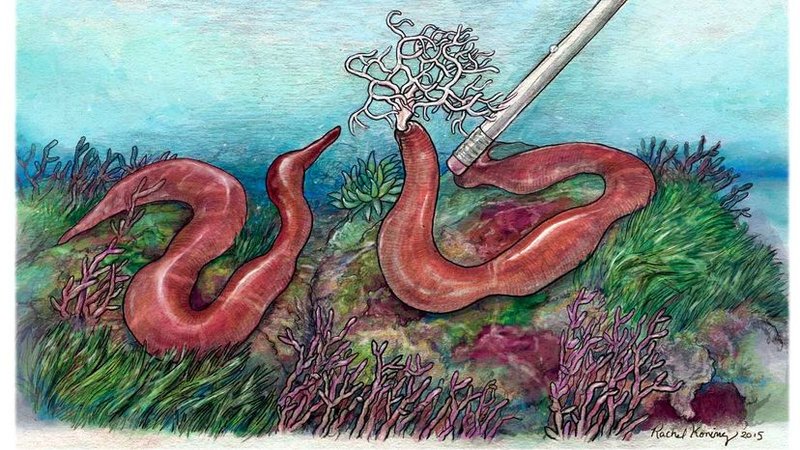
Keeping bootlace worms in captivity isn’t as straightforward as setting up a fish tank. These worms have specific needs and behaviors that can make them tricky to manage. Let’s dive into what you need to know about their habitat, diet, and the challenges you might face if you’re considering keeping them for research or simply out of curiosity.
What Are Bootlace Worms?
Bootlace worms, or *Lineus longissimus*, are long, slender worms that live in marine environments, primarily found in European waters. They belong to the phylum Nemertea, which is often referred to as ribbon worms. Their unique feature is their length—these worms can grow to incredible sizes, making them one of the longest animals on Earth!
You might picture a bootlace worm squirming through the ocean floor, using its small head to probe the substrate for food. They’re not your usual worm; they have a nervous system, a complete digestive tract, and even the ability to regenerate. Imagine losing a chunk of your arm and growing it back—that’s the bootlace worm for you!
These unique traits make bootlace worms interesting study subjects. But can they thrive in a controlled environment? Let’s explore the ins and outs of keeping one of nature’s longest creatures in captivity.
Understanding Their Natural Habitat
To keep bootlace worms in captivity, it’s vital to understand where they thrive in the wild. These worms typically reside in sandy or muddy substrates on the ocean floor, often burrowing into the sediment to hide from predators. Their habitat is usually associated with other marine life, where they can find ample food and protection.
In a laboratory or home setting, replicating this habitat can be a challenge. You’ll need a tank that mimics the temperature, salinity, and substrate of their natural environment. This means using marine salt mix to create saltwater and including sandy or muddy bottoms in your tank. Think of it like creating a mini beach in your living room—keeping things cozy is crucial for these elongated critters.
It’s striking how much their natural conditions influence their behavior and health. If you don’t nail down these factors, you might find them stressed or even refusing to eat, which leads us to our next point: their diet.
What Do Bootlace Worms Eat?
Bootlace worms are carnivorous, feeding primarily on small invertebrates and plankton in their natural habitat. Think of them as the stealth hunters of the ocean floor. They use a proboscis—an elongated appendage—to catch their prey, which is quite fascinating to observe. Imagine how a chameleon catches its meal with precision; bootlace worms do something similar but underwater.
Replicating this diet in captivity involves providing a balanced mix of food options. You might consider offering live or frozen food like brine shrimp, small fish, or other marine invertebrates. Here’s a quick list of potential food items for your bootlace worms:
- Brine shrimp
- Live or frozen plankton
- Small marine invertebrates
- Finely chopped pieces of fish
Feeding time can be a challenge since these worms are known to be picky. If they don’t recognize their food, they might not eat at all. You might want to experiment to see what they prefer, but patience is key. Don’t be surprised if it takes a while for them to adjust to their new feeding routine!
Challenges of Keeping Bootlace Worms in Captivity
While bootlace worms can be intriguing to study, keeping them in captivity presents several challenges. One major issue is recreating their natural habitat effectively. Many enthusiasts find it difficult to manage water conditions, such as salinity and temperature, which can lead to stress or illness in the worms.
Another challenge is their elusive nature. Bootlace worms can be quite shy, often burrowing into the substrate when disturbed. This means you might not get to observe their behavior as much as you’d like. If you’re hoping for an interactive experience, prepare to be patient. It’s sometimes like waiting for a shy cat to come out from under the couch!
Lastly, keeping bootlace worms safe from other tank inhabitants is crucial. If you have other marine creatures in your setup, they may view the worms as food or competitors, leading to stress or potential harm. You’ll need to carefully select tank mates, focusing on non-aggressive species.
Setting Up the Perfect Tank for Bootlace Worms
If you’re excited about setting up a tank for bootlace worms, you’ll want to take a few key steps to ensure their comfort and well-being. First, select a spacious aquarium—ideally, 30 gallons or more—to give them plenty of room to move. Remember, these worms can grow quite long!
Next, create a suitable substrate. A mix of sand and fine gravel works well, allowing the worms to burrow and feel secure. You might also want to include some decorative hiding spots, like rocks or driftwood, to give them more options for shelter.
Maintaining water quality is just as important. Regularly check and adjust salinity, temperature, and pH levels to mimic their natural environment. You can invest in good filters and perform routine water changes to keep everything in check. It’s like being a personal trainer for your worms—keeping them fit and healthy means doing your part!
Ethical Considerations When Keeping Bootlace Worms
Keeping any creature in captivity raises ethical questions, and bootlace worms are no exception. It’s essential to consider the impact of removing them from their natural habitat. If you’re planning on collecting bootlace worms from the wild, make sure it’s legal and sustainable. Avoid taking them from environments that are already under stress.
Additionally, think about their well-being. Are you prepared to meet their specific needs? The commitment to keeping them healthy and happy should be your top priority. It’s not just about having a cool pet; it’s about being responsible.
You might also want to explore alternative options, like observing bootlace worms in their natural habitat rather than keeping them in a tank. It’s a great way to enjoy their beauty while minimizing your impact on the ecosystem.
So, can bootlace worms be kept in captivity for study? In short, yes, but it comes with a unique set of challenges. They require specific environmental conditions, a proper diet, and careful attention to their care. If you’re willing to put in the effort and do your research, you might have the chance to observe these fascinating creatures up close.
Whether you want to study their behavior, learn about their biology, or simply enjoy a slice of marine life at home, keeping bootlace worms is an adventure. Just remember the importance of ethical practices and the responsibility that comes with keeping any living creature. With the right setup and a commitment to their care, you can create a thriving environment for these extraordinary worms. Happy worm watching!

